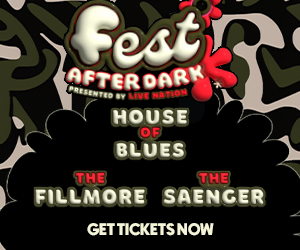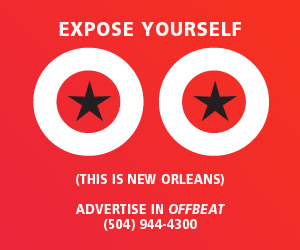Sunday, May 1, 2011 was a day for the Jazz Fest record books. As the sun ascended to its afternoon perch, a substantial crowd convened at the Fais Do-Do Stage. Shortly after 2, the Honey Island Swamp Band took the stage. In the hour that followed, the hard-working band named after the marshlands just north of the Crescent City amassed a congregation the size of which that slice of the Fair Grounds had rarely seen. The show was a scorcher; the reception, unprecedented; and the moment, galvanizing. Still, the claps and cheers couldn’t be a further cry from the off-kilter way that the tandem of Chris Mulé and Aaron “A-Ron” Wilkinson came together a decade earlier.
“Aren’t you a bass player?” Davis Rogan hollered across the bar at a young Aaron Wilkinson in 2001. “Do you wanna do a gig in Mississippi tomorrow?”
“Tomorrow?” a soused Wilkinson said. “Sure.”
“I’ll pick you up in the morning,” Rogan said. “You can learn the tunes on the way.”
Rogan’s band at the time, All That, an eight-piece hip-hop/funk consortium, had come undone and was on the verge of collapse. The gig in question was at Proud Larry’s in Oxford, Mississippi, a solid nine-hour drive from the Big Easy. Guitarist Chris Mulé was on board for the ride as well.
“I’m picking you up in 10 minutes,” Mulé remembers Rogan telling him the next morning, “Then we’re going to pick up this bass player, and you’re going to show him the entire repertoire on our way to the gig.”
“So he picked me up in the band van,” Mulé says. “[It] was just a coffin of a van. A vault with no windows and only a La-Z-Boy recliner and a beanbag in the back.”
“I had a few second thoughts before I jumped in,” claims Wilkinson.
After a brief introduction, they were off, Davis behind the wheel, Mulé slouched in the recliner, and Wilkinson holding tight atop the beanbag.
“I sat there and gave him a lesson, showed him all the bass lines,” Mulé says. “By the time we pulled up to Proud Larry’s, we were just finishing. ‘All right,’ I said, ‘now let’s get out and really play’.”
Following that gig, Mule and Wilkinson parted ways, crossing paths only every so often. In 2004, the pair reconnected, throwing in their lots with Eric Lindell as he eyed a record contract with Chicago’s Alligator Records.
It was during Lindell’s time at Alligator and their tenure in his band that Mulé and Wilkinson began to step into their own, honing their chops on the road, and sowing the seeds of a songwriting partnership that would, shortly thereafter, yield the Honey Island Swamp Band.
“In that time, I got to know Chris really well, and with Eric’s help, Chris and I started writing songs together,” Wilkinson says. “Lindell’s such a great improviser. He’d sing lyrics, just throw stuff out there, and eventually something would stick.
“We wrote several songs just strumming on my parents’ back porch,” he continues, describing a revelatory series of breezy, Pensacola afternoons that the three shared between gigs in Florida.
Months later, Mulé and Wilkinson would draw on these formative experiences under a much more severe set of circumstances. After wrapping up a West Coast swing with Lindell in the fall of 2005, the pair found themselves stranded in San Francisco with little else aside from their instruments and the clothes on their backs, their homes and possessions taken by Hurricane Katrina.
“We were stuck in a city we didn’t live in,” Wilkinson says. “We didn’t have any money. We didn’t know that many people. We literally didn’t have anything to do, so we sat there at my girlfriend’s apartment and over the course of two, maybe three, days, compared notes. I went down to the Goodwill Store on Haight Street and bought a $1 tape recorder. I showed him all of my songs. He showed me all of his songs, and we worked through each other’s stuff.”
Mulé and Wilkinson had never thought seriously about forming a band together. They became closer while playing in Lindell’s band, but it wasn’t until they found themselves on their own two time zones from home that the two got busy, burning through their backlog of songs and penning new ones.“We discovered that the songs each of us were writing meshed with the other’s,” says Wilkinson, whose pension for country music led him to put away his bass in favor of the mandolin. He had also put serious effort into developing his vocals and begun toying with the harmonica.
Mulé, who had previously put his spare time into a solo project, felt an instant connection between his roots-oriented approach to blues and R&B and his friend’s new leanings. “Aaron was really getting into the mandolin, and I knew he was a good songwriter,” Mulé says. “I was used to doing solo gigs in New Orleans, but he had never tried singing lead in a band before. I heard the way he sang and was like, ‘All right, now let’s get out and really play’.”
Confident in their material, the pair headed over to the Boom Boom Room, which, due to owner Alex Andreas’ long-standing ties to the Big Easy, had become a safe haven for displaced New Orleans musicians. It was a fortunate fluke that just as Mulé and Wilkinson struck up a conversation with Andreas about picking up an occasional duo gig, in strolled bassist Sam Price and drummer Garland Paul. “It just seemed in the stars,” says Price. “Here we were in San Francisco with the instrumentation for a New Orleans band.” Several drinks later, the still unnamed four-piece had secured a Sunday night slot, a gig they would hold down for the better part of a year.
Over the course of 2006, the Honey Island Swamp Band—a moniker coined by a hung-over Mulé upon Andreas’ pressing—crafted a flavorful blend of country-tinged blues-rock that crested atop deep, New Orleans-inflected rhythms. Taking cues from Mule and Wilkinson’s songwriting approach, the band saw their weekly showcases as an opportunity to come into their sound organically.
They cut a self-titled EP at the distinguished and soon-to-be-defunct Record Plant in Sausalito. This experience convinced the band of the viability of its sound and compelled the members to reconvene upon their return to New Orleans. Says Paul of the time, “In the beginning it was just a way for us to get together and play. After we put together that first batch of songs, we knew we were a unit.”
The Honey Island Swamp Band has matured from a burgeoning local act to a regional powerhouse to a touring outfit poised for a national breakthrough. The partnership between Mulé and Wilkinson has continued to flourish, sharing the mic onstage and the songwriting duties off. The band brought keyboardist Trevor Brooks into the fold in 2010, and it has garnered a sizable fan base across the country and served up two worthy studio efforts (2009’s Wishing Well and 2010’s Good to You).
2011 proved to be a watershed year for the group. In addition to etching its name into Jazz Fest l ore, Honey Island Swamp Band traveled to more than 90 cities, played 160-plus shows—including 35 festivals—and logged its first international gig, the Ottawa Bluesfest in Canada.
More recently, the Honey Island Swamp Band laid down the tracks for its third full-length with illustrious producer John Porter (the Smiths, Keb’ Mo’), who stumbled upon them at behest of saxman Jimmy Carpenter. “I caught them inadvertently, or advertently, on a gig, and quite dug the vibe,” says Porter. With several projects on his plate, Porter kept their demo in his car. “One day, I was working on another album, and I went for a drive. Music was playing, and I just assumed it was WWOZ. I kept thinking, ‘This band’s really fucking good. If they were only recorded right.’ Four songs later, I realized it was their demo.”
As soon as he finished his current project, Porter reached out to Mulé and Wilkinson, and the three met at Wilkinson’s home, each with a guitar and a notebook. “We just sat around with three guitars and scratched them out,” says Porter. “Several of the songs, we didn’t have to do much at all. Others, they had basic ideas for that we would hone in on and shape up. We really enjoyed ourselves, and we enjoyed ourselves at the studio, the same.”
In early April, with the album still in Porter’s hands for mixing, a Jazz Fest release date seems unlikely. When Mulé, Wilkinson, and Brooks take the stage at Chickie Wah Wah for a rare acoustic performance Saturday, April 7, the atmosphere is loose. With a twang and a ramble, Mulé and Wilkinson trade songs on the fly and work covers from Robert Johnson, George Jones and Jimmy Cliff into a set list that harkens back to some of their early collaborations. Brooks follows their lead, jangling the keys and occasionally working a couple of bars from his new accordion into the melody. With only a small crowd and a few familiar faces on hand, the show is spontaneous;the reception, warm; and the moment intimate. For the tandem of Wilkinson and Mulé, the scene is a far cry from their wild first run-in and a fond reminder of the series of events that brought the Honey Island Swamp Band together.
Honey Island Swamp Band plays Jazz Fest on Thursday, May 3 at 2:05 p.m. on the Acura Stage.





